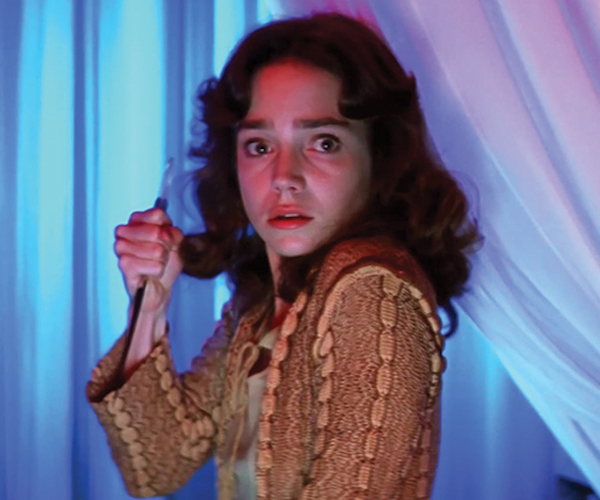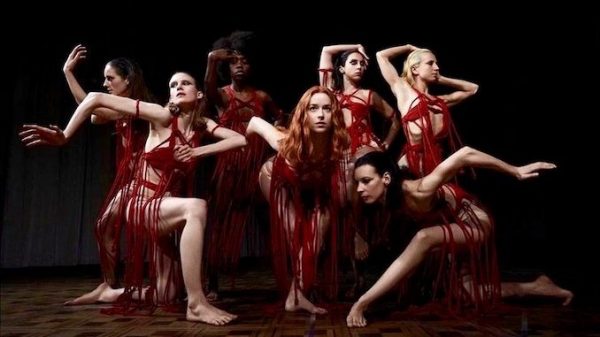Film Review: A Pair of “Suspirias” Square off at The Brattle Theater
By Peg Aloi
Luca Guadagnino’s Suspiria is a landscape of the shadowy feminine, steeped in ancient magic, willful evil, and the cyclical round-de-lay of death and rebirth.

Jessica Harper in 1977’s “Suspiria.”
This weekend, Cambridge’s Brattle Theatre presents both versions of Suspiria: Dario Argento’s 1977 cult classic and Luca Guadagnino’s 2018 remake. I highly recommend seeing both as a double feature. Take in the 1977 original first, if you can (especially if you have never seen either). Though seeing the remake first would be an interesting strategy. Comfort yourself with some snacks — and maybe sprinkle a bit of salt around your seat for protection.
Both films have prologue style openings, but the 2018 version’s is divided into chapters, an acknowledgement that an intricate and ancient legacy is at work. The film is essentially a tale of a dance academy run by a coven of witches: Argento teases out this information a bit more slowly that Guadagnino does. The latter’s version opens with a young dance student (Chloe Grace Moretz) rambling, frightened, about witches to her therapist in his dimly lit office. Then, a dying patriarch draws her last breaths on a bucolic farmstead among her children, clad in homespun pastels. We then see Susie Bannion (Dakota Johnson), a young American dancer, arriving in Berlin via Ohio at the Markos Academy.
The remake’s complex yet realistic opening is antithetical to the opening of Argento’s Suspiria, whose early scenes are highly stylized, featuring garish colors, red and blue lighting, rain, Gothic architecture, and pulsating music. A sedate marble Art Deco era building — inhabited by evil witches — makes for a more jolting dramatic discovery in the new version. Guadagnino is suggesting something about the pedestrian nature of evil and its familiarity, as well as its desire to blend in with the everyday. Argento’s film telegraphs its deviltry via atmospheric lighting and a haunting score by Goblin.
Guadagnino begins his Susperia with a book-filled office along with pastoral shots of a farmhouse surrounded by fields and a copse of tall trees. The director’s use of nature to charm and beguile is familiar to those who saw his heady romance Call Me By Your Name (a film with many visual and thematic parallels to Bertolucci’s coming-of-age story, Stealing Beauty). But the fecund hills of Tuscany are a far cry from the dreary and foreboding cityscape of Berlin, particularly the cold, pale green marble building that houses the modern dance school. The visuals may seem bland at first — but they grow richer and lusher as the story progresses.
The two films find Susie (played by Jessica Harper in the original, she has a cameo in the remake) befriending one student and learning about the recent disappearance of another. Susie (Dakota Johnson)’s dorm room is right next to Sara’s (the superb Mia Goth). The two bond over Patricia’s sudden departure from the school, which Sara finds suspicious, and she vows to find out more. (In both films, efforts to discover the truth are punished with witchcraft-fuelled revenge.) Susie wants to concentrate on her dancing, seizing an opportunity to take on Patricia’s role in a high-profile performance piece, which means being mentored by head teacher Madame Blanc (Tilda Swinton, who also plays two other roles). Another dancer is angered by Susie’s move, flinging accusations of witchcraft, leaves in a huff, and soon meets a very, very grisly demise. Rehearsals mainly consist of Susie improvising moves that the other dancers riff on, with our protagonist practicing jumping as high as she can — a metaphor for witchy flight? Maybe.
Witches are everywhere in this school: they are the “matrons,” the instructors who skulk about in dowdy woolen suits and sensible shoes. Argento’s witches are nowhere near as numerous or as consistently visible as Guadagnino’s. The remake also provides information (though it’s shadowy and subtle) about what the witches do — their purposes and plans. We see them early on, convening in a dim, shadowy kitchen, sitting around a long table eating, drinking, and smoking. We hear their whispered hopes for resurrecting “the mother”; a strange dreamlike roll-call vote is taken in which the witches choose sides. They gather regularly in a nearby bar for raucous nights of wine and laughter.

A scene from 2018’s “Suspiria.”
These small but crucial roles are played by fabulous character actors such as Angela Winkler (from Netlfix’s Dark), Fassbinder alum Ingrid Caven, French actress Sylvie Testud, and newcomers like fashion model Alek Wek. The scenes with these witches are given a realistic intimacy — grainy, melancholy, and foggy. I was reminded of the final ensemble scene in Inland Empire where the women dance in the dingy hotel lobby with pride as well as a hint of sad desperation. Guadagnino’s witches turn out to be rather Lynchian in their unapologetic physicality, their faces indelibly present whenever evil is afoot.
And oh my, the aura of evil is pervasive. The cinematography by Sayombhu Mukdeeprom (who also shot Call Me By Your Name) is luscious and, at times, unabashedly grotesque: even hard-wired horror fans may find themselves flinching. The music is dreamy and spooky, Thom Yorke’s whispery psych-folk score generates a variety of juicily ominous moods. Swinton plies her usual brilliance: the third role in the actress’s triple-casting gimmick (sorry, it feels gimmicky) is fabulous, hidden though she is beneath lumpen prosthetics. As Susie, Johnson’s pre-Raphaelite beauty doesn’t fully compensate for what starts out being a rather bland performance. But, as the witchery ramps up, her balmy affect intensifies — her presence becomes a lightning rod for the mystery. The film avoids explaining too much, and it hardly matters given that the destination is a no-holds-barred bacchanalian ritual, culminating in the rebirth of ancient matriarchal magic.
The newly-imagined Suspiria looks and feels worlds apart from the original. Argento’s memorable use of color is mostly absent here (until the gory final scenes), his Gothic visuals supplanted with more prosaic palettes. But Guadagnino’s first foray into horror is nevertheless stunning: despite it realistic trappings, it is bold and perverse. His heady romance Call Me By Your Name focused on youth and masculinity and tenderness in a decadent era, set amid sunlit orchards and sand-colored palazzos. But his Suspiria is a landscape of the shadowy feminine, steeped in ancient witchery, willful evil, and the cyclical round-de-lay of death and rebirth. Pomegranates, not peaches.
Peg Aloi is a former film critic for The Boston Phoenix. She taught film and TV studies for ten years at Emerson College. Her reviews also appear regularly online for The Orlando Weekly, Crooked Marquee, and Diabolique. Her long-running media blog “The Witching Hour” can be found at at themediawitch.com.
